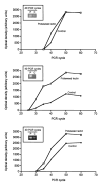Biotin uptake into human peripheral blood mononuclear cells increases early in the cell cycle, increasing carboxylase activities
- PMID: 12097659
- PMCID: PMC1435359
- DOI: 10.1093/jn/132.7.1854
Biotin uptake into human peripheral blood mononuclear cells increases early in the cell cycle, increasing carboxylase activities
Abstract
Cells respond to proliferation with increased accumulation of biotin, suggesting that proliferation enhances biotin demand. Here we determined whether peripheral blood mononuclear cells (PBMC) increase biotin uptake at specific phases of the cell cycle, and whether biotin is utilized to increase biotinylation of carboxylases. Biotin uptake was quantified in human PBMC that were arrested chemically at specific phases of the cell cycle, i.e., biotin uptake increased in the G1 phase of the cycle [658 +/- 574 amol biotin/(10(6) cells x 30 min)] and remained increased during phases S, G2, and M compared with quiescent controls [200 +/- 62 amol biotin/(10(6) cells x 30 min)]. The abundance of the sodium-dependent multivitamin transporter (SMVT, which transports biotin) was similar at all phases of the cell cycle, suggesting that transporters other than SMVT or splicing variants of SMVT may account for the increased biotin uptake observed in proliferating cells. Activities of biotin-dependent 3-methylcrotonyl-CoA carboxylase and propionyl-CoA carboxylase were up to two times greater in proliferating PBMC compared with controls. The abundance of mRNA encoding 3-methylcrotonyl-CoA carboxylase and propionyl-CoA carboxylase paralleled carboxylase activities, suggesting that PBMC respond to proliferation with increased expression of genes encoding carboxylases. Similarly, expression of the gene encoding holocarboxylase synthetase (which catalyzes binding of biotin to carboxylases) increased in response to proliferation, suggesting that cellular capacity to biotinylate carboxylases was increased. In summary, these findings suggest that PBMC respond to proliferation with increased biotin uptake early in the cell cycle, and that biotin is utilized to increase activities of two of the four biotin-requiring carboxylases.
Figures






Similar articles
-
Biotin homeostasis during the cell cycle.Nutr Res Rev. 2001 Jun;14(1):45-64. doi: 10.1079/NRR200117. Nutr Res Rev. 2001. PMID: 19087416
-
Differential effects of biotin deficiency and replenishment on rat liver pyruvate and propionyl-CoA carboxylases and on their mRNAs.Mol Genet Metab. 1999 Jan;66(1):16-23. doi: 10.1006/mgme.1998.2777. Mol Genet Metab. 1999. PMID: 9973543
-
Biotin supply affects rates of cell proliferation, biotinylation of carboxylases and histones, and expression of the gene encoding the sodium-dependent multivitamin transporter in JAr choriocarcinoma cells.Eur J Nutr. 2004 Feb;43(1):23-31. doi: 10.1007/s00394-004-0435-9. Epub 2004 Jan 6. Eur J Nutr. 2004. PMID: 14991266
-
Enzyme studies in biotin-responsive disorders.J Inherit Metab Dis. 1985;8 Suppl 1:46-52. doi: 10.1007/BF01800659. J Inherit Metab Dis. 1985. PMID: 2864473 Review.
-
The biotin enzyme family: conserved structural motifs and domain rearrangements.Curr Protein Pept Sci. 2003 Jun;4(3):217-29. doi: 10.2174/1389203033487199. Curr Protein Pept Sci. 2003. PMID: 12769720 Review.
Cited by
-
Holocarboxylase synthetase regulates expression of biotin transporters by chromatin remodeling events at the SMVT locus.J Nutr Biochem. 2008 Jun;19(6):400-8. doi: 10.1016/j.jnutbio.2007.06.002. Epub 2007 Sep 27. J Nutr Biochem. 2008. PMID: 17904341 Free PMC article.
-
K12-biotinylated histone H4 marks heterochromatin in human lymphoblastoma cells.J Nutr Biochem. 2007 Nov;18(11):760-8. doi: 10.1016/j.jnutbio.2006.12.014. Epub 2007 Apr 16. J Nutr Biochem. 2007. PMID: 17434721 Free PMC article.
-
Sodium-dependent multivitamin transporter gene is regulated at the chromatin level by histone biotinylation in human Jurkat lymphoblastoma cells.J Nutr. 2009 Jan;139(1):163-6. doi: 10.3945/jn.108.091967. Epub 2008 Dec 3. J Nutr. 2009. PMID: 19056636 Free PMC article.
-
Functional characterization of sodium-dependent multivitamin transporter in MDCK-MDR1 cells and its utilization as a target for drug delivery.Mol Pharm. 2006 May-Jun;3(3):329-39. doi: 10.1021/mp0500768. Mol Pharm. 2006. PMID: 16749865 Free PMC article.
-
Biotin Supplementation-The Cause of Hypersensitivity and Significant Interference in Allergy Diagnostics.Nutrients. 2025 Jul 24;17(15):2423. doi: 10.3390/nu17152423. Nutrients. 2025. PMID: 40806008 Free PMC article. Review.
References
-
- Zempleni J, Mock DM. Biotin biochemistry and human requirements. J Nutr Biochem. 1999;10:128 –138. - PubMed
-
- Wang H, Huang W, Fei YJ, Xia H, Fang-Yeng TL, Leibach FH, Devoe LD, Ganapathy V, Prasad PD. Human placental Na+-dependent multivitamin transporter. J Biol Chem. 1999;274:14875–14883. - PubMed
-
- Zempleni J, Mock DM. Uptake and metabolism of biotin by human peripheral blood mononuclear cells. Am J Physiol. 1998;275:C382–C388. - PubMed
-
- Zempleni J, Mock DM. Human peripheral blood mononuclear cells: inhibition of biotin transport by reversible competition with pantothenic acid is quantitatively minor. J Nutr Biochem. 1999;10:427–432. - PubMed
-
- Zempleni J, Mock DM. Mitogen-induced proliferation increases biotin uptake into human peripheral blood mononuclear cells. Am J Physiol. 1999;276:C1079 –C1084. - PubMed
